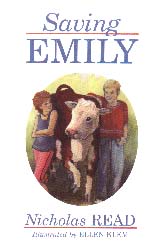| ________________
CM . . .
. Volume VIII Number 7 . . . . November 30, 2001
exerpt:
Clearly, Saving Emily has a purpose: to introduce children to the cruelty and shortsightedness that characterize commercial cattle ranching. It also, perhaps, hopes to empower children with the sense that they can make a difference. Does author Nicholas Reid, a journalist who wrote on animal issues for the Vancouver Sun, accomplish these goals? The Emily of the title is a young cow just starting the life led by most cattle. She's tagged, branded, and moved from one fattening area to another. Ultimately, she faces the slaughterhouse. In a misguided bid for empathy, Read has given Emily human thought and emotion. You can't blame him; cows are hardly cute, although illustrator Ellen Klem does her part with large-eyed, soft-focus black-and-white renderings. The characterization isn't quite believable enough, though. Marigold falls far short of modern-day mums, most of whom know that hiding the truth and lying, even to protect kids, is wrong, and, while Emily is indeed a plucky "child," she's somewhat one-dimensional. It's an unnecessary ploy, too. Children are certainly capable of feeling compassion for animals. Also, instinct still explains many of Emily's so-called human reactions to the cowboys and the trucks, for example, and science already admits that animals have emotions. The human characters are about as unbelievable. Two distinct stereotypes populate Reid's world. The majority are the ranchers, a no-nonsense, meat-and-potatoes breed who know everything about their world, care nothing about the outside world, and like it that way, thank you very much. Their wives are supportive and their kids do 4-H. Unintentionally or not, Reid has made them very much the "... bunch of know-nothing hicks with straw in their teeth and hayseeds in their brain" that Chris' mother jokes about. The other stereotype includes a small and somewhat eclectic group: women who pine for opera, stimulating conversation and gourmet coffee, and buy their clothes from city boutiques miles away and wear makeup and jewelry; eccentric old men who prefer animals over people; and children who dye their hair and sport outrageous style and opinions. These "city" types are the ones who don't fit in, and, significantly, the only ones to find kinship with newcomer Chris and his mother. Chris's role as newcomer gives Reid the opportunity to teach readers about ranching realities like tagging, branding castration, rodeos, feedlots, auction and transport operations. He's strong with facts, but stops just short of supplying the whole answer. Some dangers are obvious, but why, for example, are antibiotics and hormones bad? Necessary as it is, the detail also slows down the pace of an already passive plot. Chris's
problems are a non-story. According to the publisher's press release,
Chris is "dealing with the harsh reality of a broken home and being
forced to move from the city to the country to start a new life."
But really, he's having little trouble adjusting. His past and present
families are non-dysfunctional and loving. So he's having a bit of trouble
making friends, but what new kid doesn't? As for saving Emily, they
(the kids) don't. It took a grown-up--and one with money, furthermore--to
do that. Where's the empowerment in that solution? Emily has no power
either, for all the emphasis on her uniqueness and determination. That
Emily was in charge of her future is especially hard to take. She may
have escaped, but only coincidence and a contrived plot could At present, the majority of us are like Chris: we know little about the cruelty and will react emotionally to the discovery, but we aren't likely to do much more than hope things will change. As Reid knows, awareness is paramount to reform. Saving Emily does its best to call for change, but the message will likely go unheard if the book isn't read. Not Recommended. Cora Lee is a Vancouver writer and editor.
To comment on this
title or this review, send mail to cm@umanitoba.ca.
Copyright © the Manitoba Library Association. Reproduction for personal
use is permitted only if this copyright notice is maintained. Any other
reproduction is prohibited without permission.
Published by
NEXT REVIEW |TABLE OF CONTENTS FOR THIS ISSUE - November 30, 2001.
AUTHORS
| TITLES | MEDIA REVIEWS
| PROFILES
| BACK ISSUES
| SEARCH | CMARCHIVE
| HOME
|
